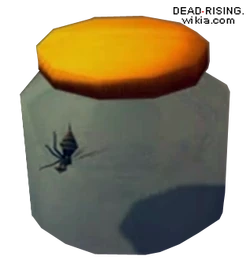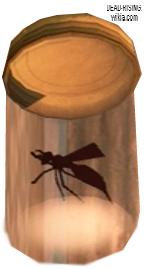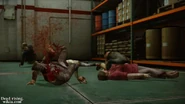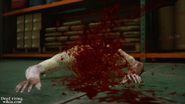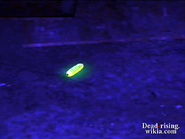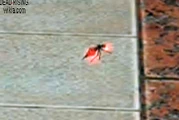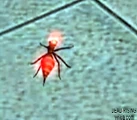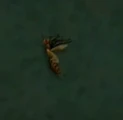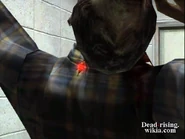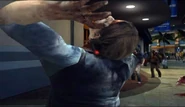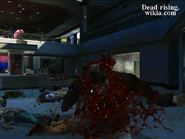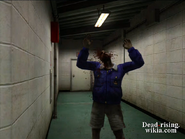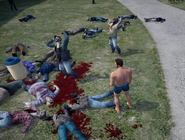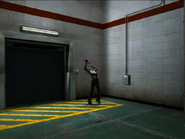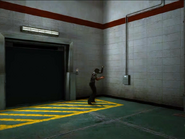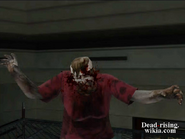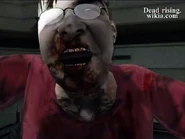| ||||||||||||||||||||||||||||
Overview (cases/scoops) • Books • Clothing • Food • Psychopaths • Stores • Survivors • Weapons
- For the Dead Rising 2 weapon, see Queen (Dead Rising 2).
The Queen (or Ampulex compressa giganteus, also referred to as "zombees") is a weapon in Dead Rising and the cause of the Santa Cabeza and Willamette Colorado zombie outbreaks.[1]
Some zombies are being controlled by a queen; when Frank kills them, they will release this small flying insect. The queen can then be collected in a glass jar (Frank will produce one automatically, Frank doesn't have to have any in your inventory) and used like a grenade. Throw it and all zombies within a 10 foot radius will die. Frank should always try to have one of these with him at all times in case of emergency.
Locating queens[]
The easiest way to find queens is by:
- listening for a high-pitched buzzing, or
- looking for a zombie standing still, looking up with its arms clawing slowly above its head.
Origins[]
This parasitic insect was found in a "region bordering the Pachacamac River." by Dr. Russell Barnaby's research team. "Particularly notable is this species' extremely large size. Some fully-grown specimens easily dwarf what were heretofore considered to be the largest known wasp species."[1]
Dr. Russell Barnaby's research team were planning to use the species to speed up the production of livestock for American consumption. The researchers experimented on rats then cattle to observe what the newly discovered species would do to its host.[1]
Dr. Barnaby's research notes[]
Notes from Dr. Russell Barnaby, Lead Biologist:[1]
This document will attempt to outline certain details regarding the parasitic insect extracted from the region bordering the Pachacamac River. Such a specimen has never before been recorded. We are assuming it to be a new species.
Judging strictly by the organism's physical appearance, it likely shares some genetic similarity to the Ampulex compressa, commonly known as the jewel wasp. It utilizes its conical ovipositor to implant eggs directly into a host. The eggs then hatch, forming a parasitic relationship with said host. Particularly notable is this species' extremely large size. Some fully-grown specimens easily dwarf what were heretofore considered to be the largest known wasp species. This has led to speculation that this particular species is likely an evolutionary offshoot of one of these known large-scale varieties.
1) A fertilized female incubates its eggs within the womb. 2) When the parasite discovers a potential host (generally the South American butterfly known as Thysania agrippina), it injects an egg into the hosts body. 3) The virus injected along with the egg effectively prevents the host's immune system from recognizing the contamination, facilitating the larva's growth while keeping the host's physiology blissfully unaware of the danger lurking within. 4) The larva excretes a parahormone that stimulates the host's appetite, then absorbs the resultant nutrients to fuel its own growth cycle. 5) Once the parasite has grown to the appropriate stage, it devours the host from within, emerging from its cocoon as a full-fledged adult.
The parahormone excreted by the larva could have myriad practical applications. The details can be found on the attached sheet, but allow me to summarize that data by stating simply that this biological agent represents nothing short of an epochal advance for both the pharmaceutical industry and the field of animal husbandry. Researchers at the site are currently working around the clock to discover ways of harnessing the amazing potential that this hormone and the creatures that secrete it represent to the advancement of science and industry. Allow me to summarize in the space below the results of a recent experiment whose results were quite promising.
Wasp specimens drawn directly from the wild are unable to deposit their eggs in organisms other than those to which they are typically naturally drawn (see above reference to the Thysania agrippina). This experiment utilized a group of lab rats whose immune system had been deliberately weakened. Specially altered larvae were then injected by researchers into said rats and the parasitic process observed. The process was observed thusly: 1. Injected larvae move through the rat's bloodstream. 2. Larvae enter the spinal column and begin moving toward the brain. 3. Because the larvae display a proclivity for consuming brain tissue from within, the simultaneous injection of multiple subjects results in the rapid death, paralysis, or, at the very least, significant reduction in the motor skills of the host. 4. For the duration that the rats remained alive, they displayed a marked increase in appetite brought on by the larvae's parahormone. 5. Additionally, rats who reached stage 4 were able to consume items that no rodent would normally consider to be appropriate food. We postulate that this mechanism is in place to guarantee a steady supply of nutrients for the parasite. As we delve into further research, we will doubtless learn how to harness the properties we have seen displayed thus far. It is our duty as scientists and stewards of knowledge to guide humanity down a path paved with great biological advancements, utilizing natural phenomenon to our advantage. It is my firm belief that this project will not only benefit our fine nation, but will also have great and lasting implications for the entire planet. Russell Barnaby, lead Biologist Addendum: I have elected to call this as of yet unnamed species "Ampulex compressa giganteus" due to its similarities to the aforementioned Ampulex compressa and its unusually large size. Since this name is rather long and unwieldy, some of the staff members here have taken to calling the specimen "zombees" -- a rather crude reference to the nature of the host's reaction to infection. Personally, I think they've indulged in too many B-movies, but I cannot argue with the appropriateness of their chosen moniker... |
Trivia[]
Queen infected zombies will throw up blood if Frank comes to close. The blood makes Frank cough and take damage.
- Queens kill zombies through elevator doors and on different floors. For example if Frank drops a queen on the second floor, zombies on the first floor will also die.
Video[]
thumb|300px|left|Cutscene 15 - Introduction to the queens
Images[]
Larva[]
- Shooting out of host
- Outside of host
Queen close up[]
Queen burrowed in neck close up[]
Infected zombie spitting blood[]
Two queens[]
Occasionally there will be two infected zombies, side by side.
Infected zombies[]
Notes[]
- ↑ a b c d Li, Richard, The Origins of Dead Rising's Zombies Little parasitic wasps could be the culprit, 1up.com, (August 28, 2006). Provided by Capcom.
The web-page explains:
No one knows what happened to the residents of Willamette, Colorado.
Willamette was like any other city -- children playing on the streets, people going to work, families shopping in air-conditioned malls.
But something strange happened. As if a diabolical experiment gone wrong, the entire population turned into flesh-eating zombies, robbed of their own free will except for one thing: to devour any humans in their way.
Although the zombie origins are still a mystery, 1UP uncovered startling new details about parasitic insects and its relationship with the zombies. The report "Notations on Research of Parasitic Wasp Organism," authored by lead Biologist Russell Barnaby, may explain what created the zombies.
From Barnaby's notes, the most alarming matter is how a new species of wasps, found along the Pachacamac River, act as a parasitic entity with its host, then a common lab rat. By entering the bloodstream, the wasp moves through the bloodstream, up the spinal chord, and towards the brain, where it will slowly devour the tissue until the host becomes a vapid shell. "...some of the staff members here have taken to calling the specimen 'zombees' -- a rather crude reference to the nature of the host's reaction to infection," said Barnaby, rather skeptical of his coworkers observations.
It remains to be seen if this Barnaby's research is a direct correlation to the events of Willamette, Colorado, but for those who want to know more about the backstory of Dead Rising, Barnaby's research notations, provided by the nice folks at Capcom, is definitely an interesting read.
